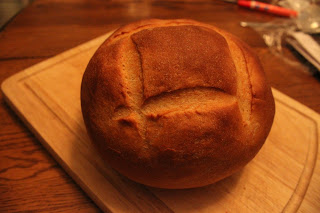One of the great points that Peter Reinhart makes in the BBA is that baking and cooking should not be a process of blindly following steps in a book, but the chef should know the purpose behind each process. Certainly, in baking, the proportions of ingredients are of more importance than in general cooking. However, we can use "formulas" instead of recipes for this. Then, how the components are assembled will determine what flavours and characteristics (structure from gluten, pockets of air, etc.) are accentuated, and what is dampened (i.e. bitter flavours found in bran, and the "gumminess" of the rye).
I see a lot of parallels in learning to bake bread, at least from a philosophical/pedagogical perspective, to being a graduate student in scientific research. Perhaps this is why I've been so enamored with the bread baking process (my wife might call it "obsessed"). In many ways, most home chefs are not dissimilar to the typical undergraduate student, memorizing a list of steps or facts out of context (a.k.a. a recipe), and regurgitating them on a final test. In contrast, the goal of graduate students or post doctoral fellows (at least, the good ones), is akin to a "bread baker's apprentice": Amass the knowledge required to understand the subject, but strive for a deep understanding of why things are so, and then finally synthesize this information into a greater context, and apply it to explore new frontiers.
I'm excited to try each formula in the BBA, but I hope that I can learn to be a "spirit of the law, not letter of the law" student, as Peter Reinhart puts it. For this reason, many of my first attempts will include slight modifications or variations, simple at first, but more complex in follow-up efforts, because I think that I will learn more about the craft with this approach. Hopefully you will also learn, especially if you are baking from the BBA, from my successes and (more likely at first) my flops.



 Oo la la...
Oo la la...